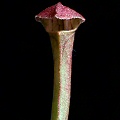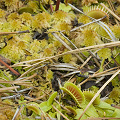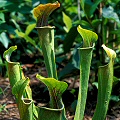Q: May I collect carnivorous plants from the wild?

Sarracenia seedling
When you find carnivorous plants, take photographs but leave the plants alone.
There are so few carnivorous plant sites left that field collection is contributing to their
endangerment.
I know, I know, when you find the plants it
is exciting and you want to take them home. But they are so easily available
from other growers that grabbing plants from the wild is almost never
justifiable. Leave them be! For example, every species of carnivorous plant in
the US is
in cultivation (with the exception of a few species of Utricularia),
and with a few month's efforts you could track them down from other growers.
I know, I know, the plant you're seeing in the wild seems different from others
in cultivation. But even with Sarracenia, a huge number of color variants
are in cultivation
and while the exact color pattern of a plant you find in the field may not be in
cultivation, plants similar enough to it already are.
I know, I know, you think that you might know better, and might be really good at
growing carnivorous plants, but you know in your heart of hearts that you shouldn't take that plant.
Just because no one is looking,
just because digging the plant out of the soft mucky ground would be the work of mere moments,
the action would not be justified. Show some respect for the wild habitat. Remember that you went through all the
work of visiting the site because you love these plants. Let them be.

Dionaea poaching
site in South Carolina
Those who field collect are shunned by conservation minded plant growers. There
are not that many carnivorous plant enthusiasts in the world, and
the names of those who collect from the field spread quickly. Keep your name clean, and
you will certainly have more chances of experiencing that overwhelming awe
of seeing carnivorous plants in the wild, because others will know they can
trust you with location information!
If you keep your name clean, trading for plants in cultivation will be
easier, too. Reputable growers do not want to be associated with field collectors.
By the way, as far as I am concerned, dealing with plants that you know were field collected is just as
bad as if you had done the collection yourself. If the plants were poached, you are growing the spoils
of poaching. I don't care if you propagate the plants; the fact remains that the plants were obtained through ethically
shady, and possibly even illegal means. It is comparable to distributing pirated
software or music CDs. (Recently it was pointed out to me that the artists or software companies do benefit to some
degree by piracy of their goods, by heightened visibility and product exposure--poached plants receive no real
benefit).

Sarracenia oreophila
I often encounter people who cite habitat destruction as justification to collect
plants, but this is usually a transparent attempt to soothe the conscience of
the collector (akin to robbing a bank because someone else will probably do
it sooner or later too). The much-cited scenario of collecting plants just before
the evil bulldozers arrive is extremely rare, much rarer than the cases of lazy
pig-eyed people snatching plants out of national parks, preserves, and private
property to bolster the size of their collections. Indeed, field collection is
usually illegal. For example,
in North Carolina (USA), field collection carries fines of thousands
of dollars PER PLANT. Marj Boyer, a North Carolina botanist,
has provided some details. Furthermore, field collection of Dionaea
is a FELONY!
Finally (and this is a very weak reason not to field collect compared to the moral
issues involved with the others), plants from the field do not have a glorious
prognosis for survival for two reasons. The first is that wild plants are often loaded
with pests---pests which can spread to your other plants. (Nature strikes back!
Ha ha!) The second is that commercial growers have selected (intentionally
or inadvertently)
plants which naturally respond well to artificial cultivation. Wild plants are
best adapted to live in the wild--leave them in peace.
Page citations: Rice, B.A. 2006a; personal observation.